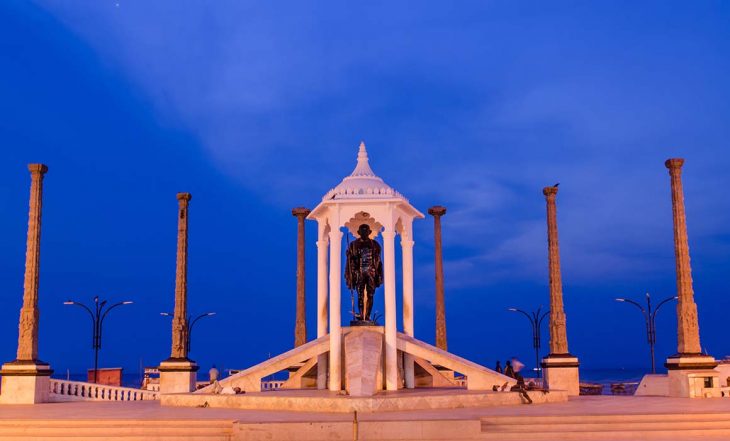At Home in Puducherry

An excerpt of the story:
From organic chocolate to al fresco theatre, cycling tours to parasailing lessons, this pretty town’s got a few secrets. Olympia Shilpa Gerald spills the beans.
Sometimes on late afternoons, when the sunshine is mellow and warm, I amble through the narrow, snoozing lanes where trees meet overhead; where commercial establishments hum beside crumbling Tamil houses, held fast by sturdy old pillars and verandas built for weary passers-by in a more trusting age. Broad, sun-dappled boulevards greet me on the other side, lined with mustard, apricot and tangerine walls with bursts of bougainvillea cascading over them; there is often a bicyclist pedalling by. Catching glimpses of blue water hugged by an even bluer sky between the streets, I quicken my pace to meet the sprawling Promenade. Beyond stretches the Bay of Bengal, cordoned off by craggy rocks, which the sea sometimes whispers to and sometimes whips, its waves crashing all over them. The dualism does not end with the colonial division of the Old Town into White and Black, French and Tamil—it remains the essence of Puducherry, where the contemporary and colonial, hedonistic and spiritual, tranquil and chaotic, past and present wonderfully coexist.
Not many cities in India can claim to be so compact and yet so cosmopolitan—the expats, people drawn by the ideology of Sri Aurobindo and the Mother, French citizens, old Pondicherrians, new settlers—all contribute to this diversity. Eventually, I learnt how to become intimate with the many shades of blue that is the Bay of Bengal, savour elusive moonrises while perched high on the rocks, relish the way it rains in one torrid, rapturous outburst. I also found that your feet are all you need to explore the town. Designed by the Dutch, coveted by the English, built by the French, engaged in trading with Rome: in this city, glimpses of Mediterranean Europe linger. The French connection is the strongest, which collides with Indian sensibilities to create a concoction that’s uniquely Pondicherry. Don’t be surprised by shoppers with strings of jasmine in their hair conversing in fluent French or if an autorickshaw-driver greets you with a resounding ‘Bonjour’. The doors and windows of the French Quarter are a fascinating study in photography, while the cool glades of Bharati Park, with the city’s iconic monument, the Aayi Mandapam are perfect to just sit and gaze. The Botanical Garden attracts many a Life of Pi fan eager to spot Richard Parker’s zoo, only to find it the fruit of fiction.
For an intimate experience of the French side of the town, stay in one of the heritage hotels that come fitted with canopy beds, like Hotel de l’Orient. The most luxurious option in these parts is LA VILLA, which balance vintage and contemporary.
The other side of the canal is a study in contrast, with its narrow streets named after temples, heady with camphor and resounding with the peals of temple bells. Stretches of Vysial Street, Eswaran Koil Street and Perumal Koil Street retain the quaint charm that once inspired celebrated Tamil poets such as Subramania Bharathi and Bharathidasan. And on Aurobindo Street, the beautifully restored INTACH building and its permanent exhibition are a standing testament to the city’s efforts to conserve its heritage and architecture. At the heart of the Tamil Quarter are the bustling Nehru and Mission Streets, flanked in equal measure by branded showrooms and street side bargain buys.
Pondicherry, I think, makes us pause to wonder, to find the parts of ourselves we lose while rushing between traffic lights, trapped in glass and steel edifices, chasing the undefined. It helps us hear our thoughts above the din and sometimes, the sound of a voice within. In the words of that much-loved fictional bear, Winnie the Pooh, “Rivers know this: there is no hurry; we shall get there some day.” Pondicherry knows that secret, too.
[“source-ndtv”]